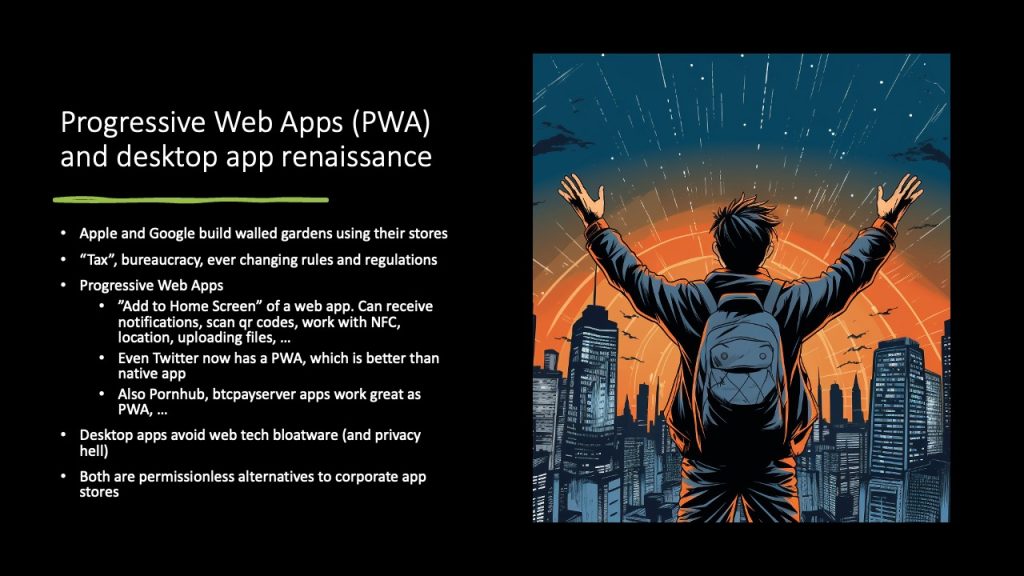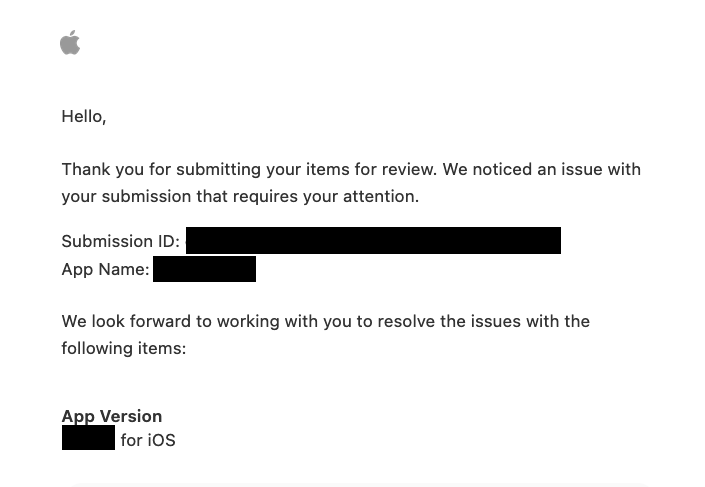I used to develop and publish a mobile app that enabled access to my courses from smartphones and tablets. However, it’s time to say goodbye to it. You can read about the reasons and the alternative in the form of Progressive Web Apps in this blog post.
Progressive Web Apps

In my short e-book Cypherpunk visions and trends 2023-2025, I explain what PWAs are about:
People moved from desktop computers to smartphones, which are dominated by two platforms and their “stores” – Google Play Store and Apple App Store. These stores try to protect users by disallowing malware, but to achieve that, they are regulated and control what can be listed and sold through them. They also regulate how payments are processed (to force app publishers to pay the “Google and Apple tax” – a percentage for processed payments).
Imagine you are an author of a Free and Open Source software (FOSS), and some insane country creates a regulation against encryption, or anonymous cryptocurrencies. Of course, your software is FOSS, so you do not care, but this regulation will be enforced by the stores.
As someone who used to have an app published in these stores, I have to say that these regulations are always changing, apps get rejected (even just new app versions that release a bugfix!) because of some new item in terms and conditions, or a tax in some country you have never heard of.
Therefore, I expect many more Progressive Web Apps (PWAs) to appear and be used by an increasing number of projects and people.
PWA is a new concept of a web application that acts like a smartphone app. You can add it to the home screen. And you do not have to use a platform’s official store app.
PWAs can have a look and feel like a native app, even use some advanced technologies (such as NFC, scanning QR codes, location, if you allow it, uploading files, access to photos, etc.). These technologies allow for apps that are permissionless.
As more regulations on encryption, privacy technologies (such as Monero) and exchanges are in force and as Apple and Google become hungrier for the fees, and more servile to the states, these kinds of apps will make more sense and will empower the users.

Picture above: A slide from my presentation about Cypherpunk visions and trends 2023-2025 at Bitcoin Pizza Day, Paralelní Polis, Prague.
Reasons I decided to stop working on a native app
I will go through a few reasons why I stopped developing the native apps and switched to a PWA. I will also explain when it makes sense to stay, or what value do the stores bring.
Development and publishing costs
Developing an app for two platforms isn’t exactly easy. While there are frameworks that make it easier (React Native, for example), you still need to compile and upload two versions of the application at a minimum. Just publishing a new version is an operation that takes tens of minutes of my time, then you have to wait for someone to approve the new version and if they don’t approve it, you have to deal with what the stores don’t like.
I’d rather focus on my work than to deal with this:

These are more or less random – I was explaining the same things over and over again, they were reported with minor bugfix releases, etc.
I am not the only person reporting this, and these reports increased lately (as Nostr clients Damus and Plebstr experienced, more on that a bit later).
A friend wrote me when I was complaining: “We had an app generator, over 200 apps generated, basically the same, but for different brands and Apple review killed our company because they always didn’t like something else and what went through in one app was “an issue” with another app. When we told them that this was not a problem with other app, they banned the other one too. And the worst thing was that even after a super small upgrade, Apple lost memory of all this process and it all started again. I used to send them a FAQ document specifically for them.“
If you are running a business, operating in this environment is not very fun.
(In)dependence
Just as with “old-style” social networks, your identity, social graph and ability to publish depend on a third party (Meta, X or Google), so is the case with app stores. Additionally, with the Android platform, the problem is that not every Android-based device also has a Play Store (e.g. Huawei).
While it is possible to publish apps on Google platforms (and soon on Apple platforms as well) directly (APK download) or via alternative app stores (such as F-Droid, or Obtainium), very few users actually do this. Thus, the amount of users of such apps decreases rapidly if they are not in the official stores.
In addition, my experience with the Play Store is quite similar to my experience with the App Store. Therefore, I don’t think the problem with the stores is only related to Apple devices. After all, Apple will have to allow side-loading of apps even outside the official App Store because of the EU. The problem is that the dominant platforms have constantly changing rules that can affect your app and your business. Or said differently – by relying on them, you as an app creator lose sovereignty, even if some users can still retain it by sideloading.
The stores have constantly changing terms and conditions. If you accept payments, you will find that in Uganda they have changed the way they collect VAT and similar amusements that you as an app creator will surely be interested in (hint: Not interested, at all).
Just as with social media, the solution was not to talk the big social networks into behaving the way we want them to behave, but to take sovereignty into our own hands, so it is done with other things. For example, I did that with the .sk domain (did not like how it operated, moved to .io) and now with the app.
By the way, with social networks, that independence is well described in this document about the old social networks and the Nostr network:
If it’s so bad, why isn’t everyone leaving?
If we criticise something, we also need to look at what these shops bring. First of all, both Google and Apple have created an ecosystem for creating high quality mobile apps. Libraries, frameworks, development tools, and the operating system around. PWAs have much more limited capabilities, and part of that is due to web technologies, not efforts to displace competing app types – after all, if Apple and Google didn’t want PWA apps at all, they wouldn’t allow/support them at all.
The stores also help with marketing, promotion and ease of installation and distribution. You can find an app in the store by searching. Often, high-quality apps even have a place in the App Store news feed, so it’s a way for users to find out about apps. Apple has done a good job of creating sort of a “magazine” inside the app store, where they write about cool apps.
Apple and Google promote apps in this way in order to later earn a percentage of the sales of the apps themselves or additional services within the app.
The stores also allow for easy installation and (automatic) updating through a single interface. And of course, there is an additional check against malicious apps and therefore you will rarely find explicitly malicious apps in the stores. That makes the phones safer for normies to use.
Stores often regulate what data apps can collect or even don’t allow them to do so without explicit permission.
In the case of my app, however, these benefits didn’t outweigh the costs – most people found out about the app from me (when they bought the course). There weren’t enough installs to make it worthwhile to maintain the app, and the stores didn’t bring me additional customers who wouldn’t have found me otherwise.
So why isn’t everyone leaving? For many, the apps are a source of income and they have found a workable model. Many are leaving (Twitter or X is building their PWA, as are various Nostr clients). And, of course, apps that could never be in app stores are building their PWAs (PornHub, for example).
What’s next?
You get the new PWA / “app” by logging into your account on my site and simply adding the page that appears after you log in to your homescreen. That’s it. No updates or anything like that is needed. You can then get easy access to courses from your home screen.
Here’s how it looks in practice:

You can learn more here.
Conclusion
It is important that we do the things we think are right. Especially as technology moves in our direction. I hope the access to the courses in this app will be good enough for you. Enjoy the courses or my books:
Also, you can follow me on Nostr here:
npub1m2mvvpjugwdehtaskrcl7ksvdqnnhnjur9v6g9v266nss504q7mqvlr8p9

